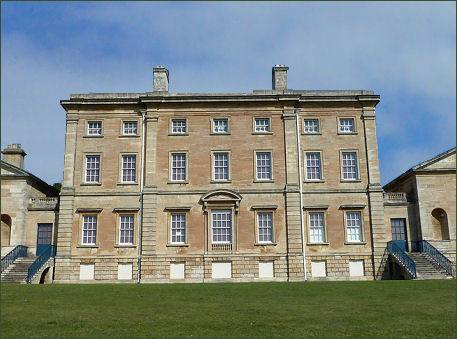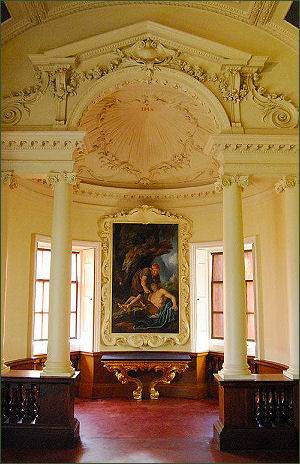Cusworth Hall
OS grid reference:- SE 546 039
 Cusworth Hall is an eighteenth century Georgian country house on the outskirts of Cusworth, near Doncaster and has been described as the jewel in Doncaster's crown. The beautiful grade 1 listed building is set in acres of historic parkland with lakes, plantations and pleasure ground with dramatic views across the town and is now a country house museum.
Cusworth Hall is an eighteenth century Georgian country house on the outskirts of Cusworth, near Doncaster and has been described as the jewel in Doncaster's crown. The beautiful grade 1 listed building is set in acres of historic parkland with lakes, plantations and pleasure ground with dramatic views across the town and is now a country house museum.
Cusworth was recorded in the Domesday Book of 1086 as 'Cuzeuuorde', a settlement has existed here since the Anglo-Saxon era. A large house is first recorded at Cusworth in 1327. The 'Old Hall' was adjacent to the walled gardens in the centre of Cusworth village, which was extended in 1726
 The present Cusworth Hall was constructed in 1740-1745 by George Platt for William Wrightson to replace the previous house and was further altered in 1749-1753 by James Paine. On William's death in 1760 the property passed to his daughter Isabella, who had married John Battie, who took the additional name of Wrightson in 1766. He employed the landscape designer Richard Woods to redesign the park.
The present Cusworth Hall was constructed in 1740-1745 by George Platt for William Wrightson to replace the previous house and was further altered in 1749-1753 by James Paine. On William's death in 1760 the property passed to his daughter Isabella, who had married John Battie, who took the additional name of Wrightson in 1766. He employed the landscape designer Richard Woods to redesign the park.
The estate was later inherited by John and Isabella's son, William Wrightson (1752-1827). It later passed to his son William Battie-Wrightson (1789-1879). When he died childless, Cusworth Hall was inherited by his brother Richard Heber Wrightson, who died in 1891. The property was then inherited by his nephew William Henry Thomas, who took the surname Battie-Wrightson and died in 1903.
He had married Lady Isabella Cecil, eldest daughter of the 3rd Marquess of Exeter. Between 1903 and 1909 Lady Isabella made further alterations to the house. She died in 1917, leaving an only son Robert Cecil Battie-Wrightson (1888-1952).
On his death in 1952, the estate descended to his sister, a nurse who had married a Major Oswald Parker but was later known as Miss Maureen Pearse-Brown. She was obliged to sell the contents of Cusworth Hall in October 1952 to meet the death duties levied at Robert Cecil's death and subsequently sold the hall to Doncaster Council.
The Council restored the grounds and also recreated what is now the tearooms within the former stable block. Visitors can experience a wealth of architecture, heritage, landscape history, wildlife and exhibitions, events and activities. The former reception rooms and spacious galleries now house the Museum of South Yorkshire life, which was opened on 30 September 1967. The musem houses toys and games, household equipment, and hundreds of photographs. Visitors can discover what life was like below stairs in the Great Kitchen, Still Room, Bakehouse, and Laundry. The Chapel (pictured above left) is an impressive room with stunning ceiling paintings.
East of the Hall is Shrubbery Walk - a band of ornamental trees including the Strawberry tree, Redwood and Ginkgo. Native trees to be found include Elder, Hazel, Yew and Holly. The lakes are home to common wildfowl such as mallard, coot and moorhen. Toads and frogs are present there, as are water scorpions and diving beetles. Other wildlife in the Country Park includes tawny owls and up to six bat species. Daubenton's or water bats can be seen at dusk.
